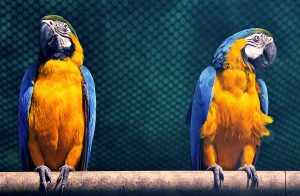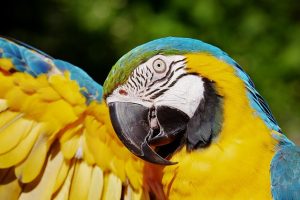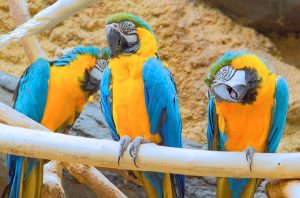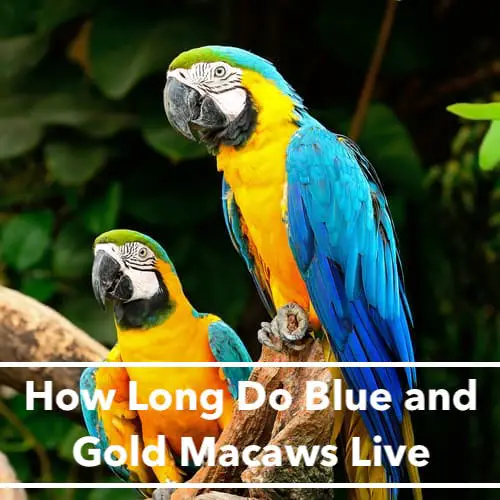Before you pick up an animal as a pet, it is important to understand its lifestyle.
This includes the foods they love to eat or find appealing/pleasurable, their house/cage dimension, and their lifespan.
This article answers the question, “how long do blue and gold macaws live” ensuring individuals interested in bringing them home someday know the task ahead.
Especially how long they would have to care for these beautiful creatures and the number of years they would stay or live as a part of their family.
Blue and Gold Macaw Lifespan on Average

The blue and gold macaws are popular macaw species with an impressive presence in homes worldwide.
Just like every other parrot, they are attention seekers. They love and rely significantly on the care and commitment they receive from their owners.
On average, the blue and gold macaws can live up to 25 years in the wild and twice the numbers (up to 50 years) in captivity under favorable conditions and settings.
While in the wild, the male and female stay committed to one partner throughout their lifetime.
The female blue and gold macaws lay about two (2) eggs at every reproductive cycle. The egg could be less than two, one in most cases but hardly go above two.
The incubation lasts for about 30 days until the eggs are hatched.
The young birds/parrots do not become fully grown (with well-developed feathers) until ten (10) weeks.
Even with their feathers fully grown, they do not become independent until several months later.
Although the blue and gold macaws start acting like adults between two and three years of age.
They are only considered adults or fully matured beginning from the age of five (5), which may extend to seven (7) in some cases.
The young female and male macaws pair up during this time, becoming mating partners.
Afterward, they find somewhere to make their home or nest, which signals the start of a new life.
Facts About How Long Do Blue and Gold Macaws Live in Natural Habitat
While in the wild, the blue and gold macaws have a lifespan of 25 years (average), which may extend to thirty (30) years.
Naturally, these birds can live longer, rising to twice the quoted number of years. The conditions/situations in the wild may not support the elongation.
While in the wild, the blue and gold macaws have to fight daily for survival.
They fight for food, safety, and protection as they navigate their way to resist attacks from predators (snakes, eagles, and other bigger animals) and other threats or dangers.
Over the years, various projects have been going on across the world, including the countries or regions where they make their home or known as their natural habitat, as the government works towards economic development and expansion.
When it comes to economic development, a popular activity that poses a high magnitude of threats/dangers to the bird’s lifespan is deforestation.
Like the other macaws, the blue and gold macaws make tree hollows one of their primary nesting places.
Hence, when trees are being cut down in their natural habitat, they have to run away as far as possible to safety as they fight for their lives.
In most cases, the young birds, especially those who do not have fully grown feathers yet, are left behind, resulting in premature or early death.
While running away, they are faced or confronted with numerous challenges.
Some of these include being forced to settle in areas that do not support free movement, depleted or insufficient food sources, and inadequate space to make their home.
All the conditions mentioned above contribute hugely towards lowering or restricting reproduction patterns.
Think about what it will look like if all these threats or dangers are not present in the wild.
The blue and gold macaws will have enough freedom to live and reproduce peacefully, enjoying the natural (nourishing and healthy) foods that nature presents to them.
How Long Do Blue and Gold Macaws Live as Pets
When the blue and gold macaws are cared for in captivity (home or zoo). These birds have the potential/tendency to live up to fifty (50) years or even more.
Thanks to the care, love, and attention they receive from their caregivers/owners.
These birds do not have to search for food, fight off possible attacks from predators, or worry about threatening evacuations from their homes in captivity.
About three years ago (2019), a particular blue and gold macaw named Charlie celebrated its one hundred and twenty (120) years. This wouldn’t have been possible if the bird had stayed in the wild.
It could have been killed by a predator or died of hunger due to lack of food and fleeing its natural habitat during deforestation for a safer place.
Evidently, captivity offers a different environment from the wild, especially when these birds are owned or adopted by individuals dedicated to their wellbeing.
When a blue and gold macaw gets the care and comfort, it needs (conducive home/cage, nourishing/healthy diets, adequate exercise, scheduled vet visits, and immediate medical attention whenever sickness/illness sets in). It lives a stress-free lifestyle.
Living for an extended number of decades becomes realistic. There are numerous situations and instances when the blue and gold macaws live longer than their owners, especially those picked up at a younger age.
While adopting or buying these birds, intending caregivers/owners should make necessary plans ahead to assure they can live a better life even when they are no longer there watching or caring for them.
You never can tell; the odds could be in the bird’s favor (provided there is no life-threatening illness or unprecedented situations that could lead to premature or unexpected death), living up to a hundred years or more, just as Charlie.
Blue and Gold Macaw Lifespan in Captivity Compared To Other Similar Birds
Usually, the blue and gold macaws, just as other macaw species or big parrots, are known to have an impressive lifespan.
This has led to various assumptions among bird specialists. Some of them believe that there must be an unknown or unreported action responsible for how long parrots live, especially macaws.
One of the numerous critical factors that can be declared responsible for how long the macaws live is that they are not impacted by oxidative stress, which humans struggle with.
Like the blue and gold macaws, many birds also possess the mechanisms responsible for limiting the effects/impacts of oxidative stress.
While the information supplied above is integral to how long the blue and gold macaws live in captivity, health care remains the most crucial factor.
Like other parrots/birds, knowing the infections, allergies, or other conditions that could result in illness or health complications in blue and gold macaws and how to quickly identify the symptoms play a significant role in enhancing the lifespan.
Before and after the bird becomes a part of your family, learn as much as possible about their lifestyle.
Most notably, the type of foods/diets they should be fed and how to ensure they live a healthy life.
When a bird owner knows about the essential factors that play critical roles in longevity, it becomes easier to create the ideal conditions suitable for the parrot/bird while in captivity.
Factors That Affect Lifespan of a Blue and Gold Macaw

When it comes to the lifespan of the blue and gold macaw, factors or conditions that play key contributions include nutrition/diet, housing, and the environment where the bird is raised or cared for.
01. Nutrition/Diet
As we mentioned earlier in one of the sections, having an explicit knowledge/understanding of what it takes to care for this bird plays a major role in how long they live or stay as a part of the family.
When the caregiver/owner feeds the bird with just any food, especially those that do not contain sufficient nutrients or have a high-fat level/composition.
It could result in serious health complications, leading to premature death if care isn’t taken.
02. Housing
The bird needs enough room to stretch its body and feathers, which may not be feasible with the wrong cage size.
When the blue and gold macaw finds it hard to move freely. Especially for owners/caregivers who do not have adequate time to spare daily to release them so that they can move freely across the house.
This could have a considerable effect/impact on the bird’s health condition.
Like humans, the blue and gold macaws need a daily dose of vitamin D, which can only be gotten when exposed to the sun.
Again, keeping the bird inside most of the time does no good. The chances of it being affected by respiratory conditions or diseases are considerably high.
It may find it difficult to inhale clean air due to constant exposure to materials/products that could contain harmful chemicals. For instance, cleaning solutions used across the home.
03. Cage Setup
Where and how the cage is placed play a significant role in the lifespan. It is always advised that the cage is placed at a spot where the bird could easily see various activities happening to prevent boredom.
Do not place the cage in dark corners or areas where there are obstructions, which could lower or restrict social/human interaction.
Also, the cage should be very far from windows, doors, and other openings, especially for owners/caregivers who live in regions with extreme weather conditions.
You can go extra by covering the cage with clothes during cold nights to ensure the bird sleeps better or eliminate possible cold attacks.
Lastly, individuals with bigger pets (dogs and cats) should ensure the cage is positioned where these animals won’t unsettle or harm the blue and gold macaw.
Table Of Blue And Gold Macaws Beautiful Cage, Foods And Accessories
| Image | Brand | Price |
|---|---|---|
 | Prevue Hendryx | |
 | Prevue Hendryx | |
 | Prevue Pet Products | |
 | Kaytee | |
 | ZuPreem | |
 | Super Bird Creations | |
 | Super Bird Creations |
Types of Blue and Gold Macaws
The blue and gold macaws are available for young and adults.
Until these birds reach the age of six (average), which is between five (5) and seven (7), they are still regarded as young macaws.
During this time, they become mature and ready to start their own life, which involves pairing with the opposite sex as they prepare to start a new family.
An adult blue and cold macaw can grow up to 36-inch in size and a wingspan of about 40-inch.
When it comes to the adult bird’s weight, the outcome or result varies between males and females.
The adult male can grow up to 1.2 kilograms (weight), while the female can weigh about 0.93 kilograms.
Color of Blue and Gold Macaws
The name wasn’t given out of proportion. It matches the bird’s physical attributes/appearance.
With its beautiful and striking blue body and the lemon-yellow (dark) pigmentation across the chest, it is impossible not to pick it out from the crowd or fail to acknowledge its presence.
The blue and gold macaws are also referred to as “blue and yellow macaws,” which also fits the bird’s appearance.
Another part of the body that has its unique coloration/pigmentation is the feathers.
The green strip of feathers is evident when you look closely at the dark beak (directly above this part of the body).
When you patiently look beneath the beak or observe it, there are feathers (black) around this area, which can be referred to as the bird’s beard due to the form/shape.
The feet’s color is black, which may also be regarded or perceived as dark gray. Whatever way it’s perceived (choosing between the two colors). Both are acceptable.
How To Take Care of Blue and Gold Macaws in Captivity?

Before anyone brings a blue and gold macaw home, either through adoption or purchase.
It is important to get accustomed to the commitments that come with integrating this bird into your home, considering the number of years it could live.
When it comes to taking care of birds in captivity, their survival and the ability to grow up to the average life expectancy or beyond depend significantly on how much care and attention the owner provides.
- Get the right cage size. A cage with dimensions (16 x 16 x 48 inches) is enough for a fully grown adult blue and gold macaw.
- If the bird won’t be released from the cage or allowed to roam around the house regularly to have a share of sunlight (for Vitamin D). Ensure the cage is placed in a corner where sunlight can pass through or spread into.
- Maintain good hygiene standards. Take out dirt, leftovers, and other contaminants regularly to prevent conditions that could pose a threat/danger to the bird’s health.
The water and food bowls should be washed daily and fresh/clean water supplied from time to time.
- As the bird grows older, the level of care and attention increases. Hence, caregivers/owners should possess a better understanding of how to care for an elderly blue and gold macaw.
- Even if the bird is active and doesn’t give any sign/symptom of illness or diseases. Ensure you book a vet appointment at least once a year while maintaining the health and safety standards/routines.
- The diets must be rich enough, providing adequate nutrients needed to boost the immune system and fight off possible attacks for a healthy lifestyle.
- Blue and gold macaws are affectionate birds who desire love and attention from their owner. Never deprive them of this joy.
Frequently Asked Questions
How Much Does The Blue and Gold Macaw Cost?
Depending on the conditions or factors associated with the purchase, a blue and gold macaw could cost on average as low as $1000 and as high as $5000.
What Factors Could Contribute To The Price of a Blue and Gold Macaw?
The amount of money an individual interested in buying a blue and gold macaw may need to pay determined by factors such as age, availability, and the breeder’s location.
Generally, young birds are more expensive than adults.
Also, if an individual is buying from a breeder overseas due to the inability to find any in their country of origin. The shipping cost and other charges will definitely raise the price higher.
Where Can I Purchase a Blue and Gold Macaw?
There are many inexperienced sellers/breeders out there. Anyone interested in buying a blue and gold macaw should make adequate consultations and findings.
If this is your first time buying/owning a pet. It is essential to seek advice from existing owners and recommend reputable breeders in and out of the region/country.
How Can I Own a Blue and Gold Macaw Without The Expensive Purchase?
After reading and understanding the resources (money, time, and attention) needed to look after them throughout their lifespan.
If you still are interested in caring for a blue and gold macaw but do not want to pay the high price to bring one home. Adoption is an alternative such an individual could explore.
Visit the adoption agency around to discuss this with the individuals in charge.
What Foods or Diets Do The Blue and Gold Macaws Eat?
These birds are great eaters. They appreciate foods such as peanuts, corn, bread, walnuts, banana, Brazil and pine nuts, orange, pecans, and many more.
Final Words
This article has comprehensively answered the question “how long do blue and gold macaws live,” highlighting the factors contributing to how long these birds can live in the wild and while in captivity.
Also, we highlighted the basic approaches/techniques that caregivers/owners can adopt and follow to ensure their blue and gold macaws live a healthy life throughout their lifespan and eliminate premature death.
Go over the sections one after the other to better understand the lifetime commitments that come with making a blue and gold macaw a part of your family.
Learn More About Blue and Gold Macaw; https://lafeber.com/pet-birds/species/blue-and-gold-macaw/

Hi, I’m Regina Rios. Just another bird lover who loves to share knowledge from personal experience. I’ve grown up with pet birds since childhood as my mommy also loves birds. As I can’t pet many birds in open air in my house as my mom does; I created my first bird cage on my rooftop using wood, copper wire, and a metal shed in 2018 and start collecting pet birds. Now, I have so many pet birds such as Macaws, Parrot, Cockatiel, Parakeet, and others. Not only that, if I see natural birds are injured I keep them in my house until they get well. Now, my hobby becomes my income source as my home birds have babies and I sell them to birds lover like mine. I’ve created this blog to inspire others bird owners by sharing my personal knowledge. Good Luck!

